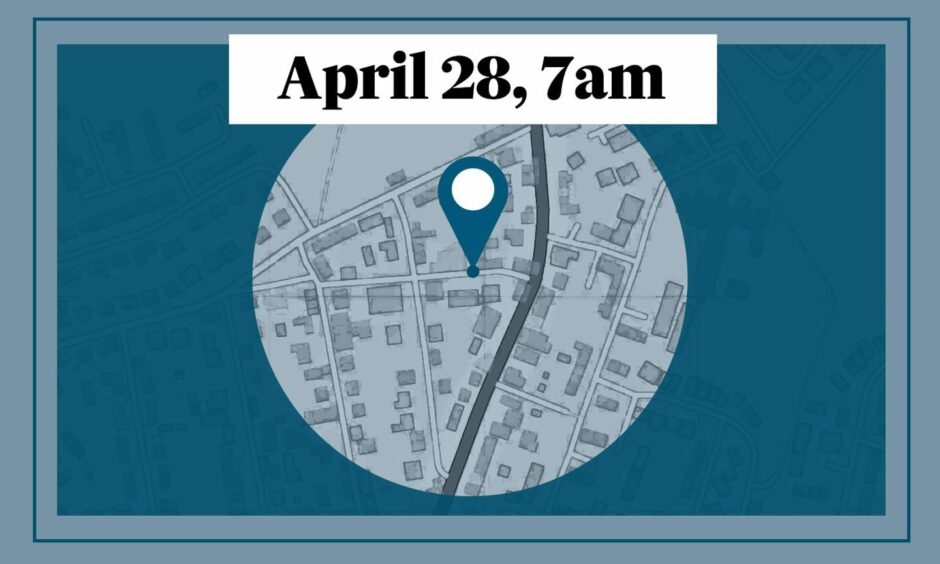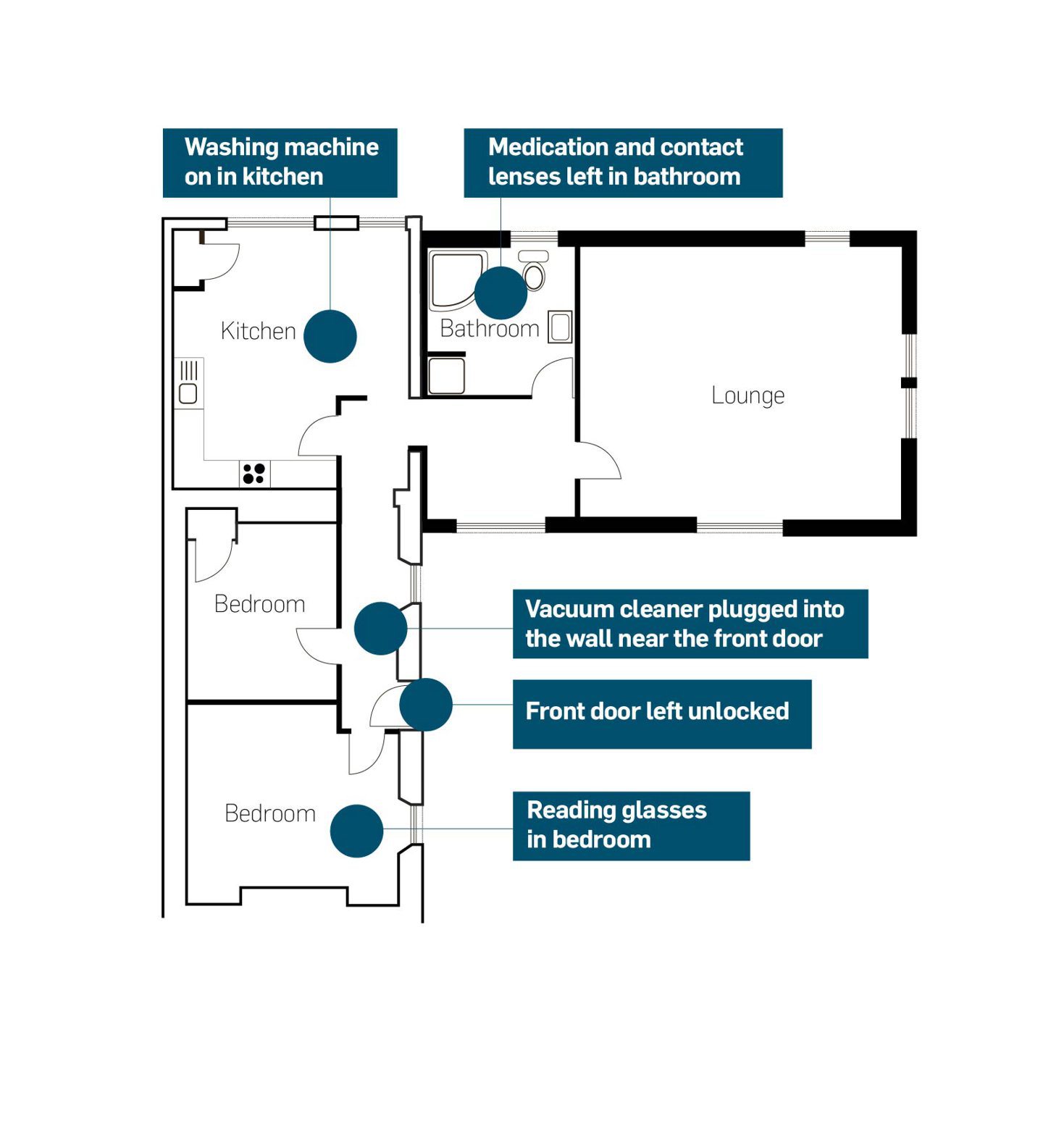
Arlene Fraser vanished from her Elgin home on April 28, 1998.
Her husband Nat Fraser would eventually be convicted of her murder.
In this article we put a spotlight on their Smith Street home and map out what we know of the events of the day, based on first-hand accounts from eyewitnesses and the police.
Arlene wakes up at her house at 2 Smith Street, New Elgin
The kids watch TV in the living room before school.
Arlene begins her housework, taking out a vacuum cleaner, the ironing board and the iron.
9.50am
A member of staff from the school calls Arlene’s landline – but it rings out.
10.25am
Arlene’s best friend Michelle Scott leaves Dr Gray’s Hospital, Elgin and drives one-and-a-half miles to Arlene’s house.
10.30am
Michelle arrives and knocks on the door – but finds the front door open, which was unusual as Arlene had been burgled before and kept the door locked.
Michelle said: “It looked like she’d just popped out.
“The washing was still in the machine.
“The hoover was lying out in the hallway.
“It was just like she’d nipped out and just left stuff.”
Michelle thought the electric appliances being on was odd as she knew Arlene had a phobia of unattended electronic appliances catching fire.
10.33am
Thinking Arlene had just popped out to the shop, Michelle walks back to her car outside and drives the one-minute journey to her home on Nicol Street.
10.33am to 12.45pm
Michelle calls Arlene’s landline “two or three times” and it rings out.
1pm
Michelle drives back to Arlene’s house, which is still empty. This time she looks around the house.
Michelle said: “I thought ‘maybe she’s upstairs having a sleep or something’.”
But there was still no sign of Arlene.
1.05pm
Michelle again left the house and drove home.
Her assumption was Arlene might have gone to Inverness to meet Jamie at the end of his school trip.
But this would have been hard because Arlene never went anywhere without her car, which had been set on fire and destroyed a few weeks earlier.
2.30pm
Arlene misses an appointment with a divorce lawyer in Elgin.
3pm
The school day ends and Jamie and Natalie leave class, walking the short walk back home.
3.01pm
The children arrive home and find nobody inside. On other days, when Arlene was at college, the kids would go to the house of Graham and Irene Higgins, who live a few doors down on Main Street.
Jamie was friends with their son, Marc.
The children walk there and go inside, explaining to Graham and Irene their mum was not home.
4pm
Arlene’s father, Hector McInnes, phones Arlene’s landline and it rings out.
7.30pm
Jamie gets a pen and some paper and writes a note.
He then walks round the corner to his house on Smith Street and fixes the note to the doorstep.
The note reads: “I was home at 7:30. You not in. I am over at Marc’s. Where are U!”
7.35pm
Jamie returns to the Higgins House on Main Street and it begins to get dark.
7.40pm
Graham Higgins, a 51-year-old electrician, calls Michelle Scott.
Michelle said: “He phoned me to say ‘have you seen Arlene because the kids are round here and she’s not at the house?’
“I said ‘no, I was meant to meet her for my lunch and she wasn’t there.’
8pm
Graham calls the police. This was before 101 existed so Graham calls the number for Grampian Police.
An officer asks Graham questions over the phone and agrees to send patrol officers.
8.15pm
PC Neil Lynch and PC Julie Clark arrive at the Higgins’ home on Main Street and speak to Graham and Irene.
They then walk over to Arlene’s house. It is still empty.
The two constables see Jamie’s note on the doorstep and the household appliances where Michelle had seen them.
They also find Arlene’s passport, driving licence, housekeys, glasses and contact lenses.
What particularly worried them was that Arlene, who had Crohn’s disease, which could be severe at times – had left her medication in the house.
The only items that appear to be missing are her purse, handbag and her brown coat.
8.20pm
The constables radio through to the duty CID officer at Aberdeen, Detective Superintendent Alan Smith, and the matter is escalated.
Mr Smith, now retired, said: “Very quickly because of Nat’s profile and the awareness of the attempted strangulation weeks earlier, she was immediately red-flagged as a highly vulnerable missing person.
“It very quickly escalated to CID and I was asked to go up and take a look at it the next day.”
8:30pm
With dusk arriving, Graham Higgins calls the landline of Ian ‘Pedro’ Taylor, who stayed on Burnside Road in Lhanbryde – almost five miles to the east.
Graham asks to speak to Nat Fraser – who was living there while on bail.
He tells Nat Arlene was missing.
Where was Nat?
When detectives interviewed Nat, they found he had a strong alibi for the entire day – almost too strong.
And it would be this alibi that partly led to him being put behind bars.
So where exactly was Nat on that fateful day?
So he is staying at a house on Burnside Road in Lhanbryde, with his friend Ian ‘Pedro’ Taylor.
Nat arrives at work – at Fraser and Taylor Fruit and Veg.
Nat and Grant arrive at the Rowantree Restaurant on High Street, Elgin, and unload a delivery.
The call, which Nat had told Hazel he would make several days earlier, lasted a few minutes.
The call ends – a minute before Arlene Fraser was last heard of.
9.41am
Nat gets back in the van and continued his rounds.
6pm
Nat drives the truck back to the Chanonry Industrial Estate and then drives his car back to Lhanbryde.
6.10pm
Nat arrives back at his temporary home and finds a message that had been left by a staff member at his children’s primary school.
They were concerned that Arlene had not answered a call about their son being collected at the end of the school day and wanted to ensure everything was okay.
8:30pm
With dusk arriving, Graham Higgins calls Nat Fraser and tells him Arlene is missing.
A few hours later, police called Nat, beginning one of the biggest missing persons’ investigations in the history of Scotland.
